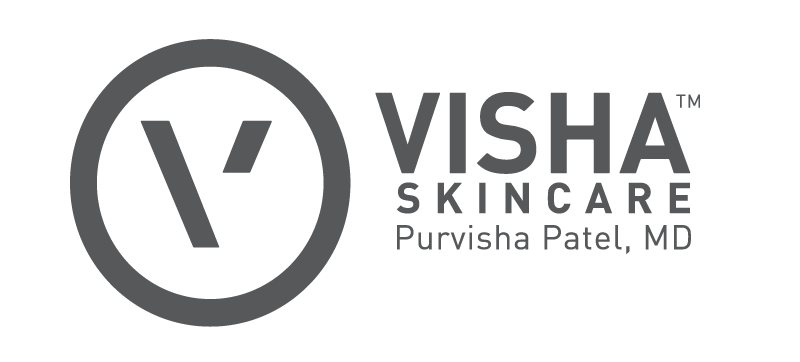
Huffpost posted "What Mandelic Acid Does for Your Skin, and the Best Products to Try". In the article Visha Skincare founder, Dr. Purvisha Patel affirms that mandelic acid works just as well as other exfoliants, only it's gentler for those who have sensitive skin. (Just please remember that it's still an acid!)
If glycolic, salicylic or lactic acid are too much for you, dermatologists suggest you try this ingredient.
Exfoliating acids — like glycolic, salicylic and lactic acid — are having a moment in skin care. In a world once dominated by harsh scrubs (looking at you, not-to-be-named apricot scrub), exfoliating acids swooped in as the superior alternative. But despite acid’s benefits, for some people they can still be too strong, leaving skin red, irritated and worse off than before. Enter mandelic acid.“Mandelic acid is a type of alpha hydroxy acid, and like its other counterparts, it exfoliates the skin,” explained Dr. Purvisha Patel, a board-certified dermatologist. As an AHA, it is in the same ranks as other popular acids, like glycolic and lactic acid, which all work by disintegrating the bonds between dead skin cells and encouraging cell turnover. And like those other acids, mandelic acid smooths texture and brightens discoloration. It can clean pores and calm breakouts. Its exfoliating nature can even lessen fine lines and other signs of aging.
This might sound a lot like what other ingredients already do, but mandelic acid isn’t just a trendy new thing. What sets it apart from similar exfoliating acids is its large molecule size. Unlike other acids, “mandelic acid doesn’t penetrate skin easily, so it sits on the surface and gently provides modest exfoliation,” explained Jennifer MacGregor, a board-certified dermatologist at UnionDerm in New York City. This is also what makes it suitable for those who have found other acids too strong. “Mandelic is often included in blends or topicals marketed to those with sensitive, dry, mature, irritable or red skin types,” she said.
But its gentle nature shouldn’t be confused with ineffectiveness. While there don’t appear to be any large studies on the ingredient, a couple smaller ones have shown that mandelic acid provides comparable results to other acids, minus the increased redness or sensitivity caused by others, especially with acne-prone skin. One study of 44 patients showed that chemical peels using a combination of salicylic acid and mandelic acid improved acne and hyperpigmentation better than glycolic acid peels. Another study with 50 patients found that while mandelic acid peels worked about as well as salicylic acid peels at clearing acne, the patients’ skin tolerated mandelic acid better with fewer side effects.
Most people will be able to tolerate mandelic acid, but it’s ideal for those with sensitive skin who find other AHAs too irritating, and for treating acne and hyperpigmentation. But depending on your goals and if you have more tolerant skin, you might want to stick to heavy hitters. “It is a very mild acid, so if you do not have sensitive skin, it will not be a stand-alone or hero ingredient,” Patel said.
Mandelic acid can be found in toner-like formulas as the main ingredient, or mixed in with serums and creams. Give it time to work: “Gentler formulas are less effective, so plan to appreciate modest benefits over four to six weeks of consistent use,” MacGregor said. And even though it’s gentle, be cautious about what products you use alongside it. “I would not mix it with retinol or vitamin C, as this can make the skin irritated,” Patel said.
If you’re ready to try mandelic acid, here are products recommended by the experts we spoke to.
Dermatologist-Recommended Skin Care Products With Mandelic Acid
1. Naturium Mandelic Topical Acid 12%
A product like this, recommended by Patel, is a good way to dive right into mandelic acid. This has a high percentage of mandelic acid, coupled with niacinamide and other fruit acids. Together, they brighten skin, reduce the look of fine lines, and exfoliate skin. If you’re new to acids, take it slow and watch how your skin reacts before moving to daily use.
2. The Ordinary Mandelic Acid 10% + HA
For more sensitive skin, both MacGregor and Patel recommend this product from The Ordinary. And at under $10, it’s highly affordable, too. Coupled with hyaluronic acid for added hydration, this formula is a good way to slowly introduce your skin to mandelic acid. Try it for acne-prone skin, to reduce fine lines, and for overall exfoliation.
3. Lumé Acidified Body Butter
Mandelic acid can benefit skin all over, including your body. Patel recommends this body butter from Lumé that adds a dose of exfoliation to your moisturizer routine. If you have rough skin or experience ingrown hairs from shaving, choosing a product with exfoliating acids can help. It’s available in unscented and three additional fragrances.
4. Paula's Choice 25% AHA + 2% BHA Exfoliant Peel
MacGregor recommends Paula’s Choice products, and this peel that incorporates 5% mandelic acid in a formula full of other exfoliating acids — including salicylic, glycolic, lactic, malic and tartaric acid — is a powerful option. Choose a peel like this to address signs of aging and sun damage, and
5. Neostrata Mandelic Mattifying Serum
MacGregor recommends this for oily and acne-prone skin due to its mattifying properties. The formula combines mandelic acid with glycolic and other AHAs to clean out pores and brighten skin.
